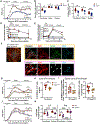Serum Amyloid A Proteins Induce Pathogenic Th17 Cells and Promote Inflammatory Disease
- PMID: 31866067
- PMCID: PMC7039443
- DOI: 10.1016/j.cell.2019.11.026
Serum Amyloid A Proteins Induce Pathogenic Th17 Cells and Promote Inflammatory Disease
Erratum in
-
Serum Amyloid A Proteins Induce Pathogenic Th17 Cells and Promote Inflammatory Disease.Cell. 2020 Dec 23;183(7):2036-2039. doi: 10.1016/j.cell.2020.12.008. Cell. 2020. PMID: 33357400 Free PMC article. No abstract available.
Abstract
Lymphoid cells that produce interleukin (IL)-17 cytokines protect barrier tissues from pathogenic microbes but are also prominent effectors of inflammation and autoimmune disease. T helper 17 (Th17) cells, defined by RORγt-dependent production of IL-17A and IL-17F, exert homeostatic functions in the gut upon microbiota-directed differentiation from naive CD4+ T cells. In the non-pathogenic setting, their cytokine production is regulated by serum amyloid A proteins (SAA1 and SAA2) secreted by adjacent intestinal epithelial cells. However, Th17 cell behaviors vary markedly according to their environment. Here, we show that SAAs additionally direct a pathogenic pro-inflammatory Th17 cell differentiation program, acting directly on T cells in collaboration with STAT3-activating cytokines. Using loss- and gain-of-function mouse models, we show that SAA1, SAA2, and SAA3 have distinct systemic and local functions in promoting Th17-mediated inflammatory diseases. These studies suggest that T cell signaling pathways modulated by the SAAs may be attractive targets for anti-inflammatory therapies.
Keywords: EAE; Helicobacter hepaticus; IBD; IL-23; SFB; T cell transfer colitis; TGF-β; Th1(∗); acute phase reactant; chronic inflammation; experimental autoimmune encephalomyelitis; inflammatory bowel disease; segmented filamentous bacteria.
Copyright © 2019 Elsevier Inc. All rights reserved.
Conflict of interest statement
Figures






References
-
- Abdollahi E, Tavasolian F, Momtazi-Borojeni AA, Samadi M, and Rafatpanah H (2016). Protective role of R381Q (rs11209026) polymorphism in IL-23R gene in immune-mediated diseases: A comprehensive review. J Immunotoxicol 13, 286–300. - PubMed
-
- Ajami B, Bennett JL, Krieger C, McNagny KM, and Rossi FMV (2011). Infiltrating monocytes trigger EAE progression, but do not contribute to the resident microglia pool. Nat Neurosci 14, 1142–U1263. - PubMed
-
- Bettelli E, Carrier YJ, Gao WD, Korn T, Strom TB, Oukka M, Weiner HL, and Kuchroo VK (2006). Reciprocal developmental pathways for the generation of pathogenic effector T(H)17 and regulatory T cells. Nature 441, 235–238. - PubMed
Publication types
MeSH terms
Substances
Grants and funding
LinkOut - more resources
Full Text Sources
Molecular Biology Databases
Research Materials
Miscellaneous

